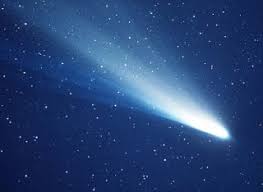Halley’s Comet – Photo: space.com
Comet Detritus Alert
I want to get this post written as quickly as I can this evening because I’d like to heed my own alert. I’m hoping I’ll manage to see at least a couple ‘shooting stars’ this evening before I head to bed. Yes: I am posting a Comet Detritus Alert.
You’ve all probably seen the articles posted recently on social media that entreat us all to make sure not to miss this cosmic show. Here’s an interesting article on the subject too. So, yes, tonight is the best night to ‘catch a falling star’ for quite a while, but it’s definitely not the only night, and of course it’s not the only meteor shower we’ll enjoy this year.
From Whence Detritus?
Halley’s Comet. That’s the source of the little pieces of rock strewn in a path through which we pass, and which cause a magical light show twice a year now, in May and October.
What I find pretty intriguing is contemplating that I made a point of peering skyward in 1986, when Halley’s Comet came blowing thorough for the first time in 76 years. I was so excited! Hard for me to believe that it was 32 years ago already.
I remember recalling how I’d heard about ‘Halley’s Comet’ all my life. In fact, it is probably the comet we know best by name – it’s sort of the cliché name that most people think of when they think ‘comet.’

Halley’s Comet – Photo: cnet. com
The Real Deal
Weirdly, though, when we located the comet in the sky that night, it looked stationary! We could see, especially using binoculars, the ‘tail’ of the comet – but it didn’t appear to our naked eyes to be really moving through the sky.
I don’t know why it felt strange, but it did. It’s not as if other heavenly bodies are stationary – and yet I readily accept that they appear stationary. Even the moon – it’s moving. But it’s not as if my eyes can detect that movement.
I think it’s because of the comet’s tail. Because the splash of light trailing the main chunk of the comet literally looks like it is moving through space, it stands to reason that it shouldn’t appear stationary from our point of view.
And yet it does.
Tonight’s Display
Actually, we’ve already begun passing through the detritus left by the tail of the comet as it passed through our inner solar system 32 years ago. It takes us just over a month to pass through that space debris twice a year (in May and October). But tonight is when the debris is thickest, and thus the meteors raining down through our atmosphere should be the most active and impressive.
Even if it isn’t the primary event, it’s nevertheless a humbling experience to realize how short our little lives here are when compared to celestial cycles such as this.
I Remember…
I remember making a point of looking for the famous Halley’s Comet when it passed by. It was in February of 1986, and the air was cold and had a bite to it, and the night sky was that midnight blue that is peculiar to deep winter.
I remember waking little Karl up so he could look at it too. Seeing Halley’s Comet is often thought of as a ‘once in a lifetime’ activity, since it shows up only every 75-76 years. But I remember specifically trying to simply explain to my little boy that he might be one of the lucky people who would actually be able to say they’d seen this amazing occurrence twice.
Karl was four and a half years old when Halley’s Comet last made its appearance. And yes, it was anticlimactic precisely because we couldn’t see it streaking across the sky. My son was decidedly not ‘wowed’ by the spectacle.
Nevertheless, I loved imagining him seeing it again when he was 79 years old or so – certainly not an outrageous dream – and telling his grandchildren how his mother, their great grandmother, dragged him out of bed so he could witness an event – twice – that’s only supposed to be a ‘once in a lifetime’ experience.
(T-767)
